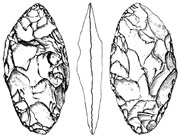Palaeolithic 500'000 - 8000 BC
 In general the Palaeolithic archaeology of the south west is poorly known. However river deposits from the most recent period of repeated glaciations (known as the Pleistocene) in the upper reaches of the extinct Solent River, and its western tributaries in Dorset and Wiltshire provide a key context for Lower and Middle Palaeolithic archaeology. The Solent River basin gradually widened and deepened to become the Solent channel between the isle of Wight and the mainland. Collection of artefacts in these areas has been extensive. More recent Upper Palaeolithic evidence is much scarcer.
In general the Palaeolithic archaeology of the south west is poorly known. However river deposits from the most recent period of repeated glaciations (known as the Pleistocene) in the upper reaches of the extinct Solent River, and its western tributaries in Dorset and Wiltshire provide a key context for Lower and Middle Palaeolithic archaeology. The Solent River basin gradually widened and deepened to become the Solent channel between the isle of Wight and the mainland. Collection of artefacts in these areas has been extensive. More recent Upper Palaeolithic evidence is much scarcer.
The Lower and Middle Palaeolithic (500,000 to 38,000 BC) archaeology of the AONB is dominated by open-landscape findspots within the Wiltshire Avon and its tributaries.
This is in stark comparison with the lower reaches of the Avon. Two key sites just outside the AONB are Bemerton (between the Avon and the Nadder Rivers) and Milford Hill (between the Avon and the Winterbourne Rivers). The patterns of findspots around Salisbury suggest that this was a key focus of hominin activity though artefacts from Milford Hill may have been transported by the action of rivers suggesting that valley locations upstream from Salisbury may also have been the target for hominin activity.
The evidence for activity in the Upper Palaeolithic in the AONB (38,000 BC to 8000 BC) is much scarcer and there is a minor archaeological presence for this period.
Environmental Evidence - The study of the environmental sequences of the Allen Valley identified some areas of floodplain peat and palaeochannels dating from the Upper Palaeolithic. Pollen analysis identified open herb communities with scattered juniper and possibly birch scrub radiocarbon dated to approximately 10000 BC.
This document forms part of the wider AONB Historic Environment Action Plans.
